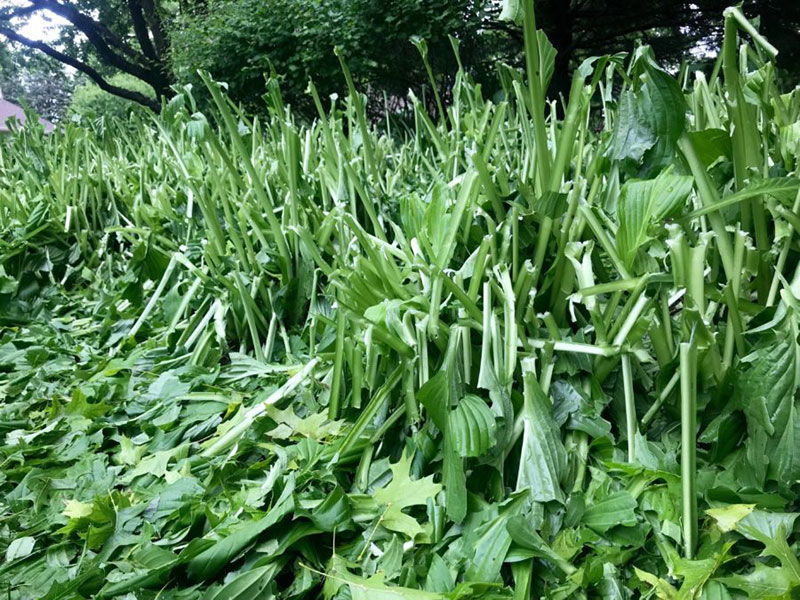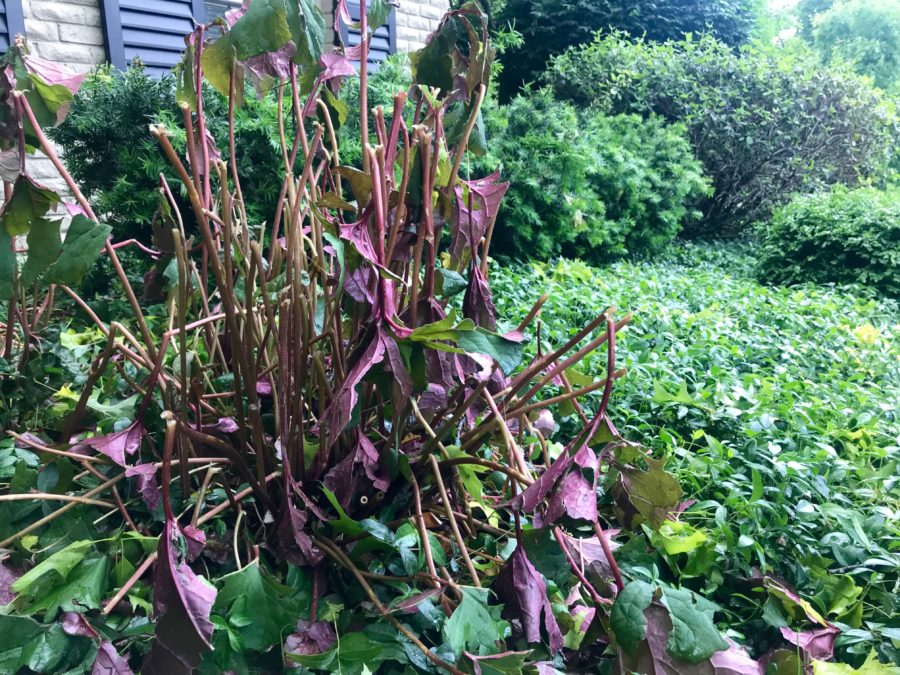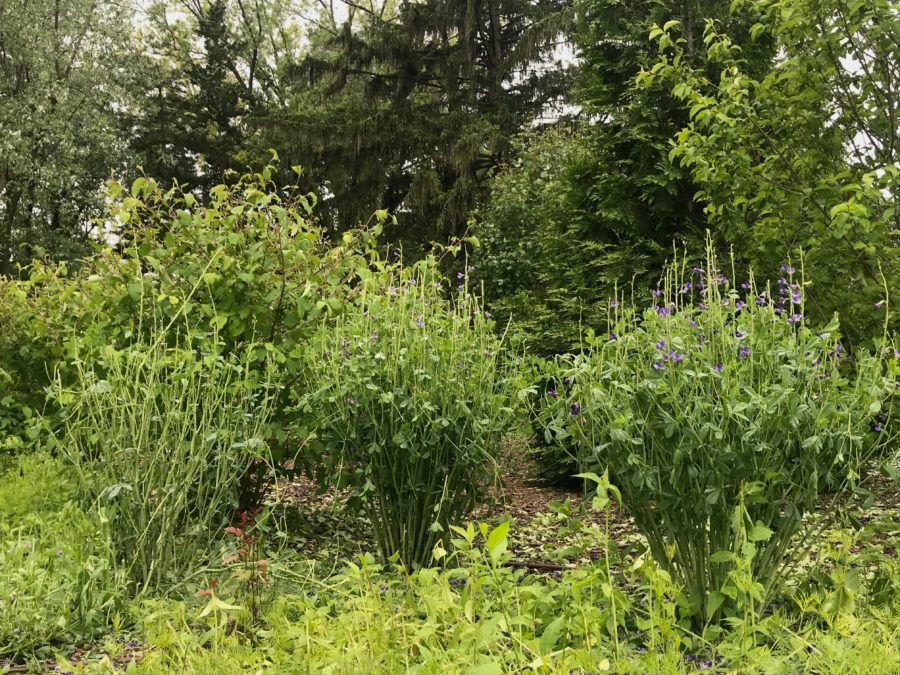In the Omaha area the post Memorial Holiday weather packed an early morning punch the following Tuesday. Heavy Rain, Strong Winds and Hail quickly tore up many of our landscapes and gardens. Now with June approaching, where do we begin in reviving a storm damaged landscape? It certainly is a helpless feeling to watch the damage occur, but following are some suggestions towards recovery

SAFETY – Always the first consideration. No one wants to compound unfortunate circumstances by getting hurt trying to fix them. Begin by looking overhead to identify both branches and utilities that are broken or hanging in place. Any one of these hazards could quickly dislodge and be headed towards the ground. Be certain to identify these conditions and contact the appropriate professionals to provide the fix prior to the risk of working in that area. Next, check the ground layer. Saturated soils are unable to withstand the weight of equipment. Some thoughtfulness and planning are needed as even a mower can cause more damage than anticipated. We don’t want to create unnecessary work in the form of ruts or getting stuck and generating undue anxiety at a time when stress is already high and can be avoided. Soil conditions will vary from location to location within the same property. No area can be guaranteed to be firm enough without observation. Unless something is an imminent hazard- we encourage patience over panic.
GENERAL CLEAN-UP – In order to more clearly see the conditions, the debris and tatter needs to be cleaned up. A broad sweep, allowing for general assessments to take place. Try not to get distracted at this stage with specific tasks. Look for patterns of damage throughout the property. For example, there could be three plants of the same type in a grouping. Two of the three look pretty good while one is totally shredded. In turn, in another location on site is a find of the same plant (all alone) and available for transplant. What could have been an orphan elsewhere can now become the solution in filling in the previous grouping.

WAIT SOME THINGS OUT – Some plants were highly susceptible to significant damage. Plants with large foliage, lush leaves and new growth took the biggest hit- one shrub in particular being Annabelle Hydrangea. The current leaves were literally stripped off the plant leaving nothing but woody stems. We suggest waiting to see where adventitious buds will break prior to any pruning. Once that is discovered, prune back to the new area of growth. If no additional bud break occurs (after sufficient time a week to 10 days) pruning back to the ground may be the only recourse. Herbaceous plants (annuals and perennials) will need to be evaluated on a case by case basis. Unfortunately, some were instantly turned into “celery stalks.” Most of your decisions with this particular plant group will lean towards improving the cosmetics of the situation. Pruning out the collection of stalks (at the base of the plant, or nearest point of growth), clipping off broken stems. While some leaves may look bad, if more than half of the leaf is intact, leave it for the time being. The plant still needs to produce energy for repair, and the leaf can always be removed once new growth emerges. If there is nothing but stems left, with no basal foliage or lateral growth, it’s time to replant.

GO EASY ON THE FERTILIZER – We recommend waiting until new growth starts to emerge before getting overly aggressive on the feeding. Let the plants initiate recovery and response first, then react with the appropriate inputs, not the other way around.
THINGS MAY LINGER IN THE LANDSCAPE BEYOND THE STORM EVENT – As plant material starts to recover, and the garden/landscape once again becomes more recognizable, additional care initiatives may last beyond the current growing season. Especially trees which suffer wounds and bruises from the forceful winds and hail. All of which need to heal and during the process such tissue damage becomes prone to potential problems. We encourage taking intentional garden walks throughout the season (at least once a week). First and foremost, becoming attentive observers of your investment. Examine the bark and keep an eye on how the healing process is progressing. Look upward, review the overall structure of the tree, there may still be some judicial pruning that needs to be done. Be selective and conservative on your pruning and removal strategy. We want to deal with all the safety hazards first, then sequence our way throughout other pruning needs that can wait until another time. The tree will work towards quicker recovery if we keep our pruning wounds to a minimum. Leaf size and color are indicators of how the recovery is progressing. We encourage keeping as many branches as possible (even the lower ones that may interfere with mowing). Reason being, we want to increase the available surface area of leaves for photosynthesis to take place, if the branch is currently not a hazard, please don’t remove it without some thought. Now more than ever, keep all the mechanical equipment away from the trunk of the tree, have appropriate tree pits so string line trimmers and mower blades don’t create more damage than already inflicted.
CHECK YOUR GUTTERS – Not very horticultural, but with all the flying debris from this storm, a Gutter Check is in order. Typically, we don’t think about a June clean out, but it may be the best post storm suggestion we can offer to keep other issues away & not take away time from being the best steward possible for your property.
Exciting! New plants in the garden! But wait....now what? How much water? When? Quick considerations before watering: Sun & Shade - Although most may say that shade gardens need less...
Spring fills us with wonder. Not in the ‘feeling of surprise mingled with admiration, caused by something beautiful’ kind of way. More along the lines of ‘what can I plant in my empty...